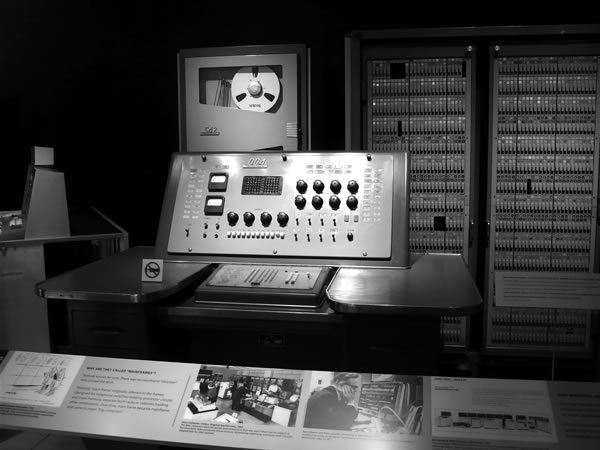I first spoke with Marc Weber as I was researching the history of tablet devices for an article on the iPad. In a half hour phone conversation, he provided a detailed “walk” down major highways and interesting side-paths through four decades of tablet design. Weber was particularly well versed on the subject because of his work for a new exhibition, “Revolution: The First 2000 Years of Computing,” which marks the completion of a two-year, $19 million renovation of the Computer History Museum in Mountain View, California. Housing the world’s largest collection of computing artifacts, including software, the museum is a must-see for anyone visiting the Silicon Valley.
The Silicon Valley was also the place where Weber grew up. After earning degrees in neurobiology and creative writing at Brown University, he returned to the Valley and became a computer consultant for clients from Apple to Canon, testing software, doing technical and marketing writing, and designing databases and user interfaces. In what turned out to be a major career shift, he moved to Geneva in 1993. That was just a few years after Tim Berners-Lee, a CERN scientist, had invented the World Wide Web. A family connection led him to Berners-Lee’s mentor, Ben Segal, who encouraged the aptly named Weber to investigate the history of the Web. With the help of some of the new medium’s pioneers, Weber co-founded the Web History Project in 1996, interviewing more than 80 people around the world. The following year, he co-organized a Web history track and an exhibit at the Sixth International World Wide Web Conference in the Silicon Valley. Weber co-founded the Web History Center in 2005, whose West Coast operations evolved into the museum’s Internet History Program.
Before finally meeting Weber in person, my wife and I walked through the exhibition, which, as its title suggests, begins with some of the earliest forms of calculation, including a video demonstration of a Japanese soroban, as well as one of the two working models of Charles Babbage’s computing engine (built from his original drawings). There is big iron hardware--a 1942 replica Atanasoff-Berry that stored bits in vacuum tubes, a 1976 Cray-1 supercomputer, and a Digital Equipment Corporation PDP-1. And then with each new gallery, the hardware keeps shrinking, until you get to the microprocessor era, with hobbyists like members of the Homebrew Club, and the commercial machines from Altair, Commodore and Apple.
Weber curated two of the galleries: “Networking and the Web” and “Mobile Computing.” In the latter sits one of the museum’s more eccentric exhibits: Steve Robert’s 1989 Internet-connected bicycle, “Behemoth,” a 580 pound monster whose console features, among other things, a Macintosh computer, a Toshiba “repackaged” laptop, speech recognition board, and GPS. As we parted, Weber pulled out his iPhone. “Almost everything on that machine can be found on this one.”
- The technology industry is so forward-looking that its history could easily slip away.
That’s particularly true for networking and the Web, where, unlike hardware, there are not many physical artifacts. By the time people realize that something online is important, it is often gone. There are at least two aspects of this history; one is the evolution of networking itself, which is my focus. My colleagues and I have done oral histories and preserved some key sites and software along with images, artifacts, and papers. The other aspect is the record of all of the things that get put online--and if they are not actively preserved, will simply disappear. The key player here has been the Internet Archive, founded by Brewster Kahle. Since 1996, they have tried to preserve pages from most Web sites as they changed over the years.
- Is the Web’
s history harder to tell because you can’ t put its artifacts on display? It was at first. But once we realized that the screenshots are the stars--the look and feel of the software rather than the physical objects--it got a lot easier. We used a number of illuminated screenshots, with physical objects and various images in a supporting role. That’s not to say some of the artifacts aren’t impressive, like the two-meter tall costume of the AskJeeves.
com mascot, Jeeves, or the early Google server rack. - In chronicling that history, did you come across lessons learned?
Many times―and what’s odd is that people are not looking to the older systems for new models. For example, there’s a lot of excitement about Facebook and other social media sites. But most people have no understanding of earlier systems like CompuServe and AOL, and even less about earlier time-sharing systems--even though they were all basically social. In a sense, the Web is returning to an older model. For the first 10 years or so, the Web was essentially a broadcast medium: people consumed content, rather than putting up their own content. Web 2.
0 and social media represent a return to earlier days, but few people would have the perspective to say: “That worked on CompuServe, so maybe we should give it a shot on the Web.” Many young filmmakers and authors spend a huge amount of time looking into the past and even referencing older works. But if you go to an academic computer science program you learn almost nothing about what came before. When it comes to networked information, our memories are short. Minitel in France, for example, had 6 million users on dedicated terminals by 1986. When I was executive editor of a multimedia magazine in ‘95, a colleague had been involved in trying to bring Minitel to Switzerland. He said that for him, the Web was deja vu. He saw the same business models―some of which worked and some which didn’t. He could look at a Web start-up and make guesses about how well it might do. If something didn’t work on Minitel, it probably won’t work now.
- In the exhibition chronicling computing’
s first 2000 years, what does that walk through history starting with sorobans and slide rules tell people? You can take many different lessons from it. A lot of it is the wonder of realizing just how much came before that has led to what we now have. I’ve heard people say that this history makes today’s technology even more amazing, but also more human. They see that at many different times and places, there were clever people working hard to solve real problems. There’s continuity to that; the technology we see today did not come out of nowhere. You realize that 150 years ago, people were doing what we’re still doing--trying to figure out a better way to calculate and handle information. If you had some mechanical or electrical skills, maybe these would be the sort of problems that you would work on.
Today, when you look at what a smart phone can do, it almost seems magical. So seeing the interim steps make you realize that it each generation built on the work of the one before. And because of that, each generation could get their arms around a problem that seemed impossible to their predecessors.
- You mentioned the difficulty of “exhibiting” the history of the Web. What about software?
Exhibiting software is more difficult than with hardware, but preserving it is essential: every machine in our museum that came after the birth of the computer requires software. There’s a story about a government auditor who wanted to weigh everything associated with the early Arpanet, which evolved into the Internet. He asked Bob Taylor, who headed the effort, how much the software weighed. Taylor told him it didn’t weigh anything--it had no physical existence. The auditor came back a week later reporting that he had found rooms full of boxes of punch cards--and they collectively weighed tons. Taylor said yes, but the software is in the holes.
Understanding software history is also more difficult than for hardware. Software comes in different languages, and a programmer or historian may not be able to read code written in a now-obscure language and appreciate the mistakes, the brilliance or the elegance, the way a film student can when watching older work, or an electrical engineer by looking at early computers. We are perhaps the only institution with a software curator, Al Kossow.
- Do you think we will we see people formally trained as Web and networking curators and archivists?
I hope so. But even if they succeed in collecting and preserving it, the next step will be to study this history as intensely as film historians study film, or writers study classic books--and perhaps there will eventually be that kind of interest. One of my motivating goals is to preserve enough records of this history so that future generations actually can study it if they wish to. We tell people that to invent the future, you must know the past. And I think we all accept that on some level. But if we don’t have some way of transmitting that knowledge and preserving key records, it can’t really happen. People will keep building no matter what, but ignorance produces a lot of wasted motion, a lot of reinventing the wheel.
- On my last trip to Japan, I met a guy who wanted to visit the Silicon Valley. But if you don’
t have connections, you can’ t get inside. The Computer History Museum is an exception, and certainly the best place to start. I have heard of tours of people from Europe and Asia that are taken around Silicon Valley. It makes you wonder what they see―maybe the Google lobby if they’re lucky. We’ve been told consistently that people would like tours of interesting places from Silicon Valley history, and that’s on my own back burner list. I could imagine a walking tour of downtown Palo Alto near Stanford University. In the space of just a few blocks you can cover a huge amount of the history of the U.
S. computer industry, including the birthplace of Hewlett Packard. You can walk through the dot. com boom and bust. This museum in many ways serves the role that museums of science and industry did for older industries. This can be the public face and collective memory of the computer industry. - How well are Japan and Asia represented in the exhibition?
I think we did reasonably well, but some of your readers should come and tell us. This exhibition, extensive as it is, is still just a tasting menu. We have reasonable representation for Japanese companies in hand-held and portable devices: I was particularly pleased to be able to show an i-Mode phone in the mobile gallery. Over time, we would like to show more of the pioneering work out of Asia―including collecting more materials and interviewing key people.




